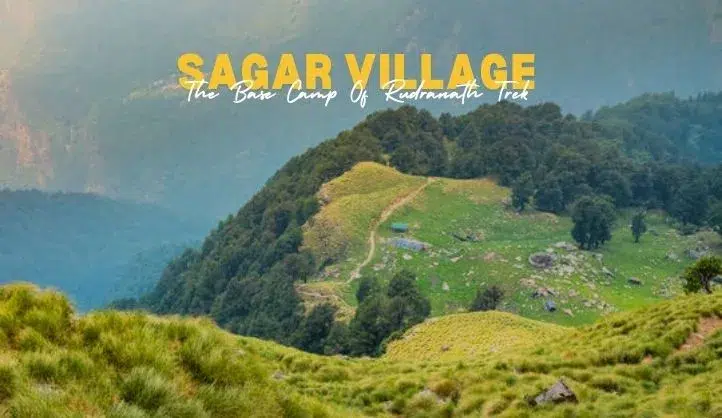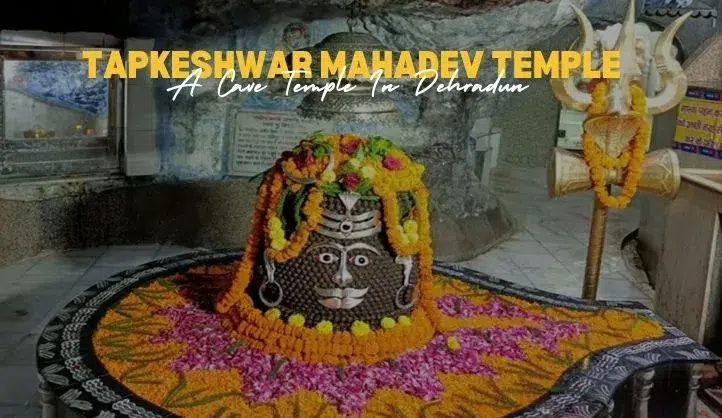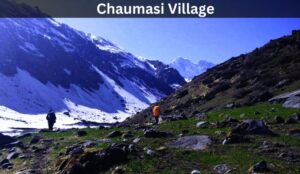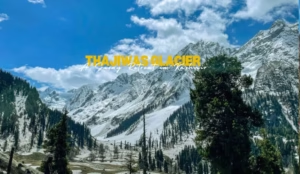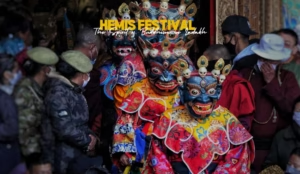Far away from the noisy cities and crowded tourist spots, there is a peaceful little village in the mountains called Sagar Village. Tucked inside the green hills of Chamoli district in Uttarakhand, this beautiful place is the starting point of the famous Rudranath trek—one of the five sacred Kedars of Lord Shiva.
But Sagar is not just a stop for trekkers. It is a place full of nature, faith, local life, and stunning views. Here, the air smells fresh, birds sing all day, and small temples tell stories from ancient times. The village is surrounded by tall trees, flowing rivers, and green fields that make you want to stay longer.
Whether you’re a spiritual traveler, a nature lover, or someone looking for peace, Sagar Village welcomes you with open arms and a warm heart. In this blog, we will take you through everything you need to know—how to reach, what to see, where to stay, and why this quiet village is truly special.
So, if you’re planning a trip to the mountains and want to explore something real and untouched, keep reading. Sagar Village might just be your next favorite place.
Quick Facts
| What | Details |
|---|---|
| District | Chamoli, Garhwal Himalaya |
| Altitude | ~2,200 m / 7,200 ft |
| Famous For | Base camp of the Rudranath Temple trek |
| Distance | 5 km from Gopeshwar • 217 km from Rishikesh by road |
| Best Months | Apr‑Jun & Sep‑Oct (clear skies, mellow temps) |
Why Sagar Village Should Be on Your Travel List
Sagar Village may be small, but it is full of beauty and charm. The green fields spread across the hills, and snow-covered mountains rise in the background. The fresh mountain air smells of pine and rhododendron trees. Villagers welcome you with warm smiles and simple food like hot dal and rice. In the evening, they often share old stories about Lord Shiva and the sacred mountains around.
What makes Sagar even more special is that it is the starting point of the famous Rudranath trek. You don’t need to drive far or hike extra just to begin the journey—the trail starts right from the heart of the village. Whether you are a nature lover, a spiritual seeker, or a peaceful traveler, Sagar Village is the perfect place to begin your Himalayan adventure.
Where Exactly Is Sagar Village
Sagar Village is a peaceful mountain village located in central Uttarakhand, just a few kilometers north of Gopeshwar town. It lies on the road that connects Chopta to Gopeshwar, making it easy to reach by road.
If you’re coming from Rishikesh, the journey takes you through the five famous river confluences (prayags)—Devprayag, Rudraprayag, Karnaprayag, Nandaprayag, and Vishnuprayag—before reaching the high valleys of Chamoli.
The village is surrounded by thick forests of oak, deodar, and rhododendron trees. In summer, the weather stays cool and pleasant. During the monsoon, mist fills the air, giving the whole place a magical feel.
Whether you love nature, silence, or scenic drives, the journey to Sagar Village is just as beautiful as the destination.
Sagar Village – Gateway to Rudranath
Sagar Village is the main base camp for the Rudranath trek, one of the five sacred temples dedicated to Lord Shiva. Located just a few kilometers from Gopeshwar, this small village is where most trekkers begin their journey. What makes it special is the ease of access—the trek starts right from the village itself, so there’s no need to travel further to reach the trailhead.
As you begin the trek from Sagar, the path takes you through thick forests, calm bugyals (meadows), and beautiful mountain landscapes. The route is peaceful, filled with birdsong and the fresh smell of pine trees. Trekkers usually stop at Panar Bugyal for the night, before moving onward to Rudranath the next day.
Local homestays and shops in Sagar provide basic stay options, food, and supplies. You can also hire guides or ponies from here. The villagers are kind and helpful, and they know the trail very well.
If you’re planning a spiritual trek with nature all around, Sagar Village is the perfect place to begin your Rudranath adventure.
How to Reach Sagar Village
Reaching Sagar Village is easy if you plan it right. Here’s how you can get there by road, train, and air:
| Travel Mode | Details |
|---|---|
| By Road | Rishikesh → Sagar (217 km / 9–10 hours) via NH-7. You’ll pass through Devprayag, Srinagar, Rudraprayag, Chamoli, and Gopeshwar. From Gopeshwar, you can take a shared jeep or taxi for the final 5 km to Sagar Village. |
| By Train | The nearest railway station is Rishikesh Yog Nagri (YNRK). From there, you can take buses or taxis early in the morning to reach Chamoli or Gopeshwar. |
| By Air | The closest airport is Jolly Grant Airport, Dehradun (232 km). You can book a prepaid cab or take a Uttarakhand Roadways bus to Chamoli or Gopeshwar, then travel to Sagar. |
Quick Tip: If you are already visiting Chopta or Tungnath, take the beautiful forest road via Mandal. It’s a quiet and scenic route that brings you straight to Sagar Village—no need to go back through the highway.
Map:
Best Time to Visit Sagar Village
Every season brings something special to Sagar Village. Here’s what you can expect throughout the year:
| Season | What to Expect |
|---|---|
| Spring (April–June) | The weather is pleasant and the skies are clear. Rhododendron flowers bloom, and it’s a great time for first-time trekkers. Perfect for sightseeing and photography. |
| Monsoon (July–August) | The village becomes very green and fresh with waterfalls everywhere. But the trekking trails get slippery, so it’s best for experienced trekkers only. |
| Autumn (September–October) | Clear blue skies and lush landscapes after the rains. It’s the best time for pilgrims and trekkers, but also the busiest season. |
| Winter (November–March) | Sagar Village stays open, but the trail to Rudranath gets covered in snow. Ideal for those who want peace, snow views, and solitude. |
Top Things to See and Do in Sagar Village
Sagar Village offers a peaceful mix of temples, nature, local life, and the Rudranath trek. Here’s what you can enjoy:
1. Visit Temples in and Around the Village
-
Sakleshwar Mahadev Temple
A small stone temple in the village with an ancient Shiva Linga. Locals believe it protects their crops from hailstorms. A quiet, spiritual place close to nature. -
Raja Sagar Temple
A bright and colorful shrine was built in memory of King Sagar, a Garhwali ruler. Evening prayers here are soft and soulful, and the temple offers peaceful vibes. -
Rudranath Temple (Trek Needed)
Just a moderate trek away from Sagar Village, this is one of the five holy Panch Kedar temples. The temple is built inside a natural rock cave, where Lord Shiva is worshipped in the form of his face (mukha). Surrounded by alpine meadows and snow-covered peaks, Rudranath offers both spiritual power and natural beauty. The trek to the temple starts directly from Sagar Village and is an unforgettable experience.
2. Walk With Nature
Sagar Village is full of small footpaths that wind through forests, farms, and meadows. You’ll hear birds chirping, see butterflies, and maybe pick some wild berries. These quiet walks are perfect for relaxing before or after your trek.
3. Meet the Locals
Sit with villagers over a cup of ganth ki chai (millet tea) and enjoy real mountain hospitality. The people here are friendly and often share stories about their farming life or collecting Himalayan herbs used in Ayurveda.
4. Start Your Rudranath Trek
Sagar is not just a village—it’s the official base camp for the Rudranath trek. From here, the trail takes you through beautiful spots like:
-
Panar Bugyal – Green open meadows are ideal for camping.
-
Pitradhar – A ridge believed to be sacred to ancestors.
-
Rudranath Temple – The final and most peaceful stop of the trek.
Whether you’re a spiritual traveler or a mountain lover, this journey from Sagar to Rudranath is one of the most rewarding treks in Uttarakhand.
Forests and Biodiversity Around Sagar Village
Sagar Village is not just a base camp for the Rudranath trek—it’s part of a delicate and beautiful ecosystem found only in the higher reaches of Uttarakhand. The forests and landscapes surrounding this village are rich in rare Himalayan flora, medicinal plants, and wildlife. Let’s explore why this region is important for biodiversity and why it needs care and attention from every visitor.
1. Rhododendron Forests – More Than Just Pretty Flowers
The hills above Sagar Village are covered with rhododendron, oak, and deodar trees. These forests are not just scenic—they are living ecosystems that support many species:
-
Rhododendron flowers, which bloom from March to May, provide nectar for bees, butterflies, and birds like the Himalayan bulbul and sunbirds.
-
The forest floor is home to insects, reptiles, and even small mammals.
-
Larger animals such as the Himalayan black bear and musk deer sometimes roam the deeper forest zones above Panar Bugyal.
Rhododendron trees also help in preventing soil erosion, filtering rainwater, and keeping the temperature stable in the area. Many locals also use rhododendron petals to make juice and chutney, known for their medicinal value.
2. The Sacred Deodar – Tree of the Gods
Known as Devdaru in Sanskrit, the deodar cedar is a sacred tree in Uttarakhand and is often found near temples like Sakleshwar Mahadev. These tall, strong trees:
-
Store large amounts of carbon, making them important for fighting climate change.
-
They are used in traditional medicine to treat colds and skin problems.
-
Provide shelter for birds and animals while also offering spiritual calmness to visitors.
You’ll often find deodar trees near ancient temples—locals believe they protect the land and the people.
3. The Mighty Oak – Backbone of Himalayan Forests
Oak trees (Quercus spp.) are another key part of the forest around Sagar. They grow well in the cool, mid-altitude zones of Chamoli and support rich biodiversity:
-
Their strong roots hold the soil and prevent landslides during heavy monsoons.
-
Fallen oak leaves turn into rich natural compost for farming.
-
Their acorns feed birds, squirrels, and wild animals.
Oak forests also support small-scale local businesses like handmade leaf plates, used in village feasts and rituals.
Trekking from Sagar Village
Sagar Village is a dream starting point for peaceful, scenic treks in the Garhwal Himalayas. From short day hikes to multi-day adventures, there’s something for everyone here.
| Trek | One-Way Distance | Highlights |
|---|---|---|
| Rudranath Trek | 18–20 km | Walk through alpine meadows and dense forests to reach Rudranath Temple, where Lord Shiva is worshipped in his face form at 3,600 meters. The views and silence here are unforgettable. |
| Panar Bugyal & Liti Bugyal | 12 km | A beautiful trail through wide open green meadows with stunning views of Nanda Devi, India’s second-highest peak. Great for camping and sunrise photos. |
| Anusuya Devi Temple & Atri Muni Ashram | 5 km (from Mandal, 8 km drive from Sagar) | Visit the mythical site where Goddess Sati was reborn as Anusuya. The temple is peaceful, surrounded by thick forest and spiritual energy. |
| Kalpeshwar Extension | Multi-day | For serious trekkers, you can extend your route to Kalpeshwar, another Panch Kedar shrine, by crossing through Hansal Bugyal. This connects you to the full Panch Kedar circuit. |
Trek Info
-
Trek Difficulty: Moderate – trails are steep but well-marked.
-
Permits Needed: No special permit required. Just carry your ID for the forest check-post.
Stay & Eat in Sagar Village
Whether you are here for a trek or a quiet mountain break, Sagar Village offers clean rooms, warm food, and local hospitality. Here are some good options to stay and eat:
| Option | Type | Notes |
|---|---|---|
| JK Homestay | Family Rooms | Includes veg breakfast, Wi-Fi, and cozy beds. Prices range from ₹800–₹1200 per person. Perfect for trekkers and small families. |
| GMVN Tourist Rest House | Dormitory & Deluxe Rooms | Government-run guesthouse. Best to book early during pilgrimage season (May–June & Sept–Oct). Basic but reliable. |
| Local Cafés | Small Tin Sheds | Simple and tasty food. Try jhangora kheer (barnyard millet pudding) and fresh berry pickles – local favorites served hot. |
Responsible Travel Tips
Traveling to Sagar Village and trekking to Rudranath is a special experience. But to keep this place clean and respectful, here are some simple things you should follow:
1. Leave No Plastic: Please do not leave any wrappers, bottles, or plastic waste on the trail. Carry all your trash back to Gopeshwar. There are no dustbins along the route, and plastic harms the forest and animals.
2. Respect Temple Rituals: When you visit temples like Sakleshwar Mahadev or Rudranath, ring the bell only once. Keep your voice low, and never take photos inside the main prayer area (sanctum). These are sacred places for the locals.
3. Hire Local Guides: Local guides know the forest paths well and also share many interesting stories. Hiring them supports the village economy and helps you stay safe and on the right track.
Packing Checklist
Packing the right things will make your journey smooth and comfortable. Here’s what you should carry for Sagar Village and the Rudranath trek:
-
Light down jacket: Even in summer, nights can get very cold, sometimes below 10°C. A warm jacket will keep you comfortable.
-
Trekking poles and rain cover: The forest trails can become slippery, especially during the rainy season. Trekking poles help with balance, and a rain cover keeps your bag dry.
-
Water filter bottle: Clean water sources are not always available. A filter bottle lets you safely drink from mountain streams.
-
Reusable tiffin box: Many small cafés and homestays serve dal-rice and other simple meals. Carrying your own tiffin box helps avoid plastic waste and is very handy during the trek.
Final Thoughts
Sagar Village is not just a stop on the map – it’s a peaceful corner of Uttarakhand where nature, culture, and spirituality come together. From green fields and forest trails to ancient temples and smiling locals, everything here feels pure and real. Whether you’re starting the Rudranath trek or simply looking for quiet time in the mountains, Sagar welcomes you with open arms.
Let WanderSky help you plan your trip with local stays, guided treks, and all the support you need. Your Himalayan journey begins here – and it will stay in your heart forever.
Frequently Asked Questions
1. Is mobile network available?
Yes, Jio and BSNL work in the village; no signal after 3 km on the trail.
2. Do I need a temple ticket?
No, entry is free; donations are optional.
3. Can beginners do the Rudranath trek?
Yes, with a guide and one night at Panar for rest.
4. Are ATMs available in Sagar Village?
No, carry cash from Gopeshwar.
5. Is food available during the trek?
Yes, basic food is available at small dhabas and camps.
6. Can I charge my phone during the trek?
Only in the village or at camps with solar power; carry a power bank.
7. Is camping allowed near Rudranath Temple?
No, camping is allowed only before the temple zone.

